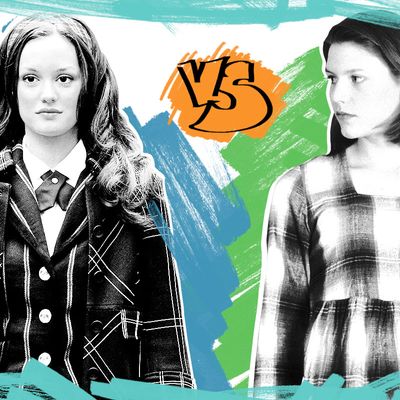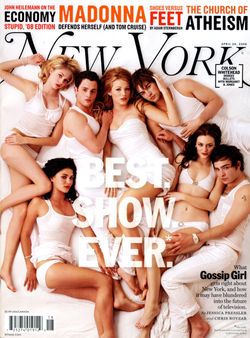
From late October through mid-November, Vulture is holding a High-School-TV Showdown to determine the greatest teen show of the past 30 years. Each day, a different writer will be tasked with determining the winner of a round of the bracket, until New York Magazine TV critic Matt Zoller Seitz judges the finals on November 13. Today’s battle: Rachel Syme judges My So-Called Life versus Gossip Girl. After you read, be sure to visit Vulture’s Facebook page to vote on which show should advance.
Hello, Upper East Siders. Gossip Girl here, and a little birdie wearing fugly Prada loafers from three seasons ago told me that your judge had kind of a tough time with this one. Or, as Angela Chase put it while laid out like a grunge odalisque on her parent’s overstuffed couch upholstered in classic mid-’90s puke-brown brocade, there is something about Sunday night that really makes you want to kill yourself, and judging this round is kind of like my ultimate Sunday. I’m filled with as much angst as Brian Krakow popping rage-wheelies in his cul-de-sac; I’m more torn up than one of Jenny Humphrey’s dress hems right before Fashion Week.
When this matchup fell into my lap, I was forced to confront a very specific cultural question: Are high-school soaps supposed to be relatable? Because these shows reside on opposite ends of that continuum, tackling, as they did, completely different high-school problems: popping a monster zit, say, versus accidentally kissing the wrong statuesque blonde by the Champagne fountain at a black-tie masquerade ball. I mean, when I was 15, I felt like I was Angela Chase. We were all Angela Chase! Who didn’t think at one point that a bottle of Manic Panic Crimson Glow dye might just change your entire life? But there was something intoxicating — and, honestly, unmatched in swagger — about Gossip Girl’s pitch-perfect first season, which took the rule book for teen drama and threw it in a blender with an Edith Wharton novel, Sex and the City, “Page Six,” and a Pantene ad.
What came out of that kinetic first season was a kind of neon energy that mimicked the exhilaration of riding in a limo on prom night — this very site covered the show like it was doing the Lord’s (or, really, Kristen Bell’s) work, charting every move of Blake and Leighton and Ed and Chase and Penn and Taylor across the city the way that freshman underlings always seem to know the coordinates of the senior queen bee. That kind of swooning for a show is very high-school! But then we swerve back again, to the dyslexic, doe-eyed elephant in the classroom, to another swoon: JORDAN. CATALANO. I could stop there. But I won’t. We have to do this. Let’s do this.
My So-Called Life premiered in 1994 on ABC on Thursday nights and lasted exactly 19 episodes. For many people, its cancellation is heresy, proof that nothing gold can ever stay (not unlike a wilting homecoming corsage). What people now forget is that MSCL was put in an almost-impossible time slot in the age before DVR: It was up against both Friends and Mad About You, decidedly adult NBC must-see sitcoms. The ratings were terrible, and Claire Danes wanted to leave to make out with Leonardo; and after she left, no one’s heart was really in it anymore. Still, the titanic combustion of Liberty High ultimately made MSCL a new kind of phenomenon: It inspired the first-ever online fan campaign to save a show from cancellation. The show became, and remains, a bona fide cult classic. If nothing else about the show’s early demise affects this battle, I will say this: The way the show so quickly etched itself into the cultural consciousness and then disappeared, leaving a trail of yearning and dashed hopes, deeply mimics the experience most of us have when reminiscing about high school.
But unlike high school, which often looks like more and more of a catty nightmare in the rearview, MSCL ages extremely well. Its creator, Winnie Holzman, who would go on to write the book for Wicked and the criminally overlooked ABC Family drama Huge, really knew her way around teen patois. What made MSCL such a gem was the way the characters talk — the verisimilitude was astounding. There was that shock of recognition every time someone opened their mouth to say something cringeworthy, that this is indeed how kids in high school communicate; if you are feeling at all vulnerable, it can hit so very close to the heart. I remember watching with disbelief that Danes was able to appear on TV sounding like she was simply reading from her diary: full of likes, ums, and like, you knows; her stock-in-trade was the kind of revelations that feel weighty to teen girls:
“People always say you should be yourself, like yourself is this definite thing, like a toaster or something. Like you can know what it is, even.”
But actually sound like the stoned ramblings of a failing philosophy major:
“… when Rayanne Graff told me my hair was holding me back, I had to listen. Because she wasn’t just talking about my hair. She was talking about my life.”
MSCL was playing with a staid genre as it defined a new one of its own — it was undercutting the hacky ideas of the “after-school special” or the “very special episode,” taking on all of the didactic ways previous programming had dealt with the issues that were most pressing to adolescents. Yes, there was the Rayanne-gets-sober episode, and the Ricky-comes-out episode (N.B.: Ricky was the first openly gay high-schooler on TV, no small feat there), and the Juliana Hatfield–as-a-homeless-angel episode that everyone pretends doesn’t exist and/or was some kind of inside joke in the writer’s room gone awry. And, yes, the show dealt with serious subjects: when to have sex, potential infidelity, peer pressure to drink and do drugs, misogynistic girl-ranking lists, learning disabilities, teacher boundaries, homophobia, weight anxiety.
But it spread these issues out across the season and throughout the minds of the ensemble so that a kind of low-level hum of constant “dealing” permeates each episode. Whatever the issue was, though, MSCL tackled it the way most high-schoolers actually tackle their dilemmas: brooding, heavy sighs, flinging yourself against furniture, debriefing with your squad in the girls bathroom. No one ever really solves anything, and no one ever knows where Tino is. There is a gray, flannel-y fog over the whole show, but that fog is where most youths tend to live.
Holzman saw right to the center of what makes teen girls tick: In their world, everything is a BIG deal. Crushes are big deals. Betrayals at the auditions of Our Town are a big deal. Getting your hand held in the hallway is basically the biggest deal on Earth. Which brings us to Jordan.
It is hard to mention MSCL without calling out Jared Leto’s baby-blues, the azure pools that launched a thousand shippers. No matter what Oscars Leto wins or man-buns he wears or circuses he lies to Terry Gross about growing up in, he will forever be Jordan Catalano, frozen in time like a yearbook picture, the most endearing heartthrob ever created. This is not an opinion, this is an empirical fact: Mention Jordan Catalano in a room full of women ages 28–40 and see what happens.
I can tell you: They get this far-off look in their eyes, a look that contains all of the budding early sexual feelings they ever had, rolled up and diverted into this one person, this boy who couldn’t read and just needed to be loved, this lead singer of the Frozen Embryos who was basically a jerk and only wanted to get laid but pulled out a heroic Cyrano act at the very end, this locus for all desire wrapped up in a leather choker and jamming out to Buffalo Tom. This boy exists at every high school. In creating such an iconic love interest for her heroine, Holzman truly won the teen pennant. If high-school dramas are meant to actually, like, reflect the real dramas of high school, then very little that came before or after has felt as authentic as Angela navigating her ardor for Jordan, and the nuclear effect that her obsession has on everyone around her.
Gossip Girl was never all that wedded to realism. Verity has no place on the Upper East Side, at the Constance Billard School for Girls, where the a cappella groups sing sassy arrangements of Fergie songs and everyone has a tab at Bergdorf’s. That dismissal of real life is what made the show so addictive right out of the gate: The producers (Josh Schwartz and Stephanie Savage, riding high off of their success with The O.C.) decided to eschew the typical predicaments that haunt most teen dramas when adapting Cecily von Ziegesar’s frothy YA candy and instead go straight for a glittery wish-fulfillment pleasure bomb. Gossip Girl is a fantasia on adolescence, the idea of what teenagers would be like if they had unlimited resources, zero consequences, closets full of couture, and mansions to live in. Spoiler: They would all be fast-quipping nightmares with tremendous blowouts!
For the sake of this contest, I am only going to consider the first two seasons of Gossip Girl, when the main gang was technically still enrolled in high school. The latter four seasons aren’t worth much nostalgic ink, with each dwindling into more ridiculous soap sexcapades than the last. It’s best not to dwell on those episodes. The writers certainly didn’t. Hi-yo!

But, oh, that first season. Three years out from Sex and the City (and before the too-big banks failed and any romantic depiction of New York excess started to look crass), the world was ready, and maybe even salivating, for another show that shone such a spotlight on the New York demimonde, tossing off bons mots at one another in their lavish drawing rooms, a high comedy of bad manners. No show ever rolled into town on such heady fumes as GG did; New York proclaimed it “The Best Show Ever” on a cover that featured the impossibly gorgeous cast and their fresh Noxema skin curled up together in a puddle of white lingerie. The show was a saga about social media, but also came of age with it — Twitter and Gossip Girl launched in the same year, and though it took the 140-character format a little while to take off, the characters of Serena and Blair shot right out of the gate and right into the cultural thunderdome.
The initial ratings for the show weren’t stellar (2.5 million viewers or so early on), but that wasn’t because it was going unwatched, à la MSCL. It was because teens were watching it online. The show dominated on iTunes. Teens were experiencing the show at the forefront of digital media, like teens always do. If Gossip Girl debuted now, it might be broadcast on Snapchat. That fervor online seeped into the fandom surrounding the show — looky-loos started texting Blake Lively sightings to gossip magazines, the cast started acting out real-life love triangles to complement their onscreen ones, and web recaps became as essential to the viewing process as the show itself. For the first time, the glow surrounding a show started to define the show; it was a real pop-history moment, both for teen dramas and for television at large.
But looking back on the show now, it evokes a Magnolia Bakery cupcake: a beautiful confection in theory, a disappointment when you actually bite in. The witty banter that flies back and forth between Dan and Serena feels like the chummy party chatter of jaded 35-year-olds, not that of winsome minors trying to figure it out. That’s the basic gambit of Gossip Girl: These kids are supposed to be tiny adults from the pilot forward. They drink martinis with olives. They have sex on old oak bars. They have their own credit cards and en suite bathrooms.
This is all fun to see coming from the mouths of babes, until it starts to feel somewhat craven. Chuck Bass, for all of his redemptive arcs later on, starts the series as a date-rapist. Dan is a Vonnegut-spouting mansplainer who tries to “actually” Serena into falling in love with him (if you need further evidence, see the poem he published in The New Yorker — LOL — called “Sluts”). Jenny is a daffy try-hard who seems not to care that she is constantly being thrust into situations where people want to rape her, put her in jail, and humiliate her, all in the name of popularity. Nate is like the long-suffering Willy Loman of privilege from the first moment he cannot bring himself to sleep with Blair. Serena confesses to murder while artfully baring her cleavage.
And then Blair — well, Blair is the hero of the show. Leighton Meester is the single most shimmering sequin on Park Avenue, a royal bitch queen who is absolutely deserving of her crown. Her insult comedy would please Lenny Bruce, and was made all the better because she tosses off her barbs in prim sheath dresses. She sprang straight from a Whit Stillman film, and her character will remain as timeless.
But this isn’t a battle about which show had the most endearing characters — Blair versus Jordan? Lonely Boy versus Krakow? The icy Eleanor Waldorf versus dadbod Graham Chase? — but which did high school drama better, which show is ultimately going to stand the test of time as a way to understand teens in their native habitat. Because, ultimately, that is what a good high-school show does. It should heighten adolescence to Shakespearean proportions without sacrificing the core qualities of high school that make it so tragicomic in the first place.
Gossip Girl broke its characters out of the prison of the classroom and let them play around the city, while My So-Called Life zoomed in on the petri dish of hormones and quotidian sorrows that fill up high-school hallways like the smell of Teen Spirit. Gossip Girl was an escape; My So-Called Life was an examination. Since there is no escaping high school — the only way out is through — I’m calling this one for Angela. Cue “Blister in the Sun.”
Winner: MY SO-CALLED LIFE
Rachel Syme is a writer and editor in New York City. Her work has appeared in The New Yorker, the New York Times, Matter, and Grantland. She is still waiting for Tino to show up.




